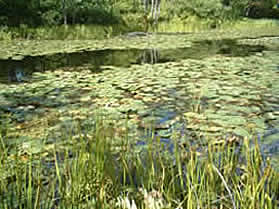A study by a Stanford ecologist recently published in PLoS Biology says that restored wetlands are 25 percent less productive than natural wetlands, even 100 years later.
The study is a meta-analysis of 621 natural and restored wetlands from 124 previously published studies. Wetland restoration and the creation of artificial wetlands has been a popular method of mitigating wetland development for decades.
The study found that wetlands with a higher flow of water (think rivers and tidal areas) recovered faster, as did areas with warmer climates. Smaller wetlands recovered more slowly than larger ones. Woe to the prairie pothole on the northern plains and to the New England bog.
Read the open access paper in PLoS Biology, here.
A detailed report in The New York Times Green blog is here.
You can find the press release from Stanford on EurekAlert, here.
Photo: Small wetlands in colder climates with limited water flow, like this Vermont wetland, recover their productivity more slowly. Courtesy Vermont Department of Forests, Parks and Recreation

